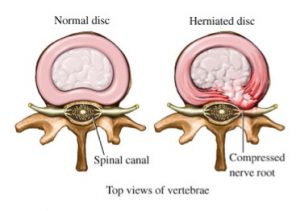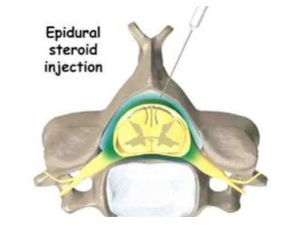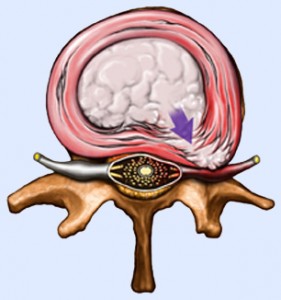Epidural injections for pain management have been providing relief for sciatica and radiculopathy pain (pinched nerves) since the 1950s along with spinal stenosis relief as well. They have been a mainstay in the field of pain management because they work really well. Overall success has consistently exceeded 75% in research studies for either neck, mid-back, or low back pinched nerve problems.
In conjunction with additional therapeutic options such as physical therapy, chiropractic treatment, spinal decompression therapy, acupuncture, and massage the non-operative success rates can achieve over 95% pain relief and avoid surgery!
If you live in Arizona and are suffering from sciatica or radiculopathy from a bulging, ruptured, or herniated disc with a pinched nerve, call (602) 507 – 6550 today for help. The best pain management doctors in Arizona are at Arizona Pain Specialists!
Where is the epidural space?
The epidural space refers to the area around the spinal cord (not in it). The covering of the spinal cord is called the dura, so the area around it is the “epi”dural space. When a nerve is being pinched, that pinching occurs in the epidural space or close to it, so the injection of steroid goes into this area.
What are the Different Types of Epidural Injections?
There are three types of epidural steroid injections for pain management including (click on each for more information):
- Interlaminar Epidural Steroid Injections
- Transforaminal Epidural Steroid Injections
- Caudal Epidural Steroid Injections
These injections work well for herniated discs (pinched nerves), spinal stenosis pain, and inflamed nerves from a chemical irritation (such as a torn disc or post-herpes neuralgia). Epidural injections may only be necessary one time or as a series of three injections. Administration of steroid injections should not be done too many times per year, which means after a series of three injections then a break should be taken.

For more information on epidural steroid injections (ESI) for specific spine areas, click on one below:
How are Epidural Injections Performed?
Epidural steroid injections are administered as an outpatient procedure using cortisone medication, most commonly for treatment of a herniated disc. There are some new medications that are coming into pain management for epidural injections that are nonsteroidal and include stem cell injections. These are not mainstream as of yet.

The injections are sometimes performed with IV sedation, but some patients only require local numbing of the skin and soft tissues around the spine. If anxiety is an issue, one in-between method is for a patient to take a Valium 30 minutes or so by mouth prior to the procedure.
The pain doctor will injecting numbing medicine into the skin and soft tissues to minimize procedure pain. The needle is placed using a real time x-ray machine called fluoroscopy, and once the pain doctor is satisfied, dye is injected to ensure accuracy. At that point the numbing medicine and steroid is placed.

Call (602) 507 – 6550 to Get Started Today or

Why are Epidural Injections Performed?
The theory behind receiving an epidural injection is not to fix the underlying problem. Rather, the injection material is a large anti-inflammatory agent and will bathe the inflamed and painful area with soothing steroid medication to provide pain relief which hopefully will last for an extended period of time.
For example, when a patient receives an epidural injection for a disk herniation (slipped disc), the medication does not make the herniated disc material go away. It can simply mask the pain while the body takes care of removing the piece of disk that has ended up where it is not supposed to be.
When a pain management doctor performs an epidural injection, the most modern treatment method involves fluoroscopy, which is a real-time form of x-ray. Studies in the past have shown that without fluoroscopy the miss rate for these injections was as high as 40%.
What are the Outcomes of Epidural Steroid Injections for Pain Management?
Surgery for a herniated disc usually has a very good outcome, but there are risks associated with the discectomy procedure. Outcomes in a JAMA (Journal of the American Medical Association) study compared between patients who underwent surgery for a lumbar herniated disc with sciatica versus those remaining non-operatively showed EQUAL outcomes at the one year point. And those avoiding surgery had no risk from the procedure (there are some minor risks of the injection though).
An epidural injection in either the cervical, thoracic, or lumbar spine can allow an individual to avoid risky surgery and to get their pain under control. This can allow patients to be able to participate more effectively in physical therapy, need less opiate medications, play with their kids, and concentrate better at work. Multiple studies over the past few decades have shown the results of these injections to be between 75% to 90% good to excellent, with most patients being able to avoid surgery. In addition, studies have shown it is better when patients undergo the injections sooner in the course of sciatica prior to it becoming chronic in nature (over 3 to 6 months).
Epidural injections are not typically meant to treat pain that stays only in the neck or back. However, if the back pain is emanating from a degenerative disc causing inflammation in the part of the disc next to the epidural space and causing an inflamed nerve root, an epidural injection may actually help.
They are primarily meant to treat the radiating pain that comes from the compressed nerves of spinal stenosis and herniated discs.
What are the Risks of Epidural Steroid Injections?
The risks of these injections are small, but real. As with any injection, there is small risk of infection (<.01%) or bleeding in the epidural space. Blood clotting medicines should be stopped 5 to 7 days before the procedure, ask your doctor for specific time frames.
A dural puncture occurs in approximately 0.5% of patients. This is when the needle inadvertently punctures the dural sac, called a dural puncture. Usually this simply heals up within a few hours to a few days. It may cause a spinal headache, called a post-dural puncture headache. This may require an epidural blood patch to seal it over.
One of the main risks is the injections may not work to relieve pain satisfactorily, which may necessitate a repeat injection. There are very rare complications including nerve damage, which may cause paralysis from an arterial injury or direct nerve trauma.
The Arizona pain management doctors at Arizona Pain Specialists are Board Certified, Award Winning Top Docs who are experts in all types of epidural steroid injections.
Call (602) 507 – 6550 to Get Started Today or
